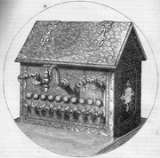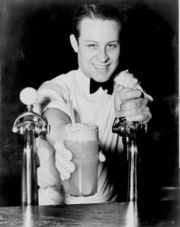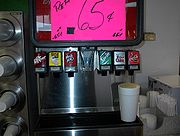
Soda fountain
Encyclopedia
.png)
Restaurant
A restaurant is an establishment which prepares and serves food and drink to customers in return for money. Meals are generally served and eaten on premises, but many restaurants also offer take-out and food delivery services...
s, concession stand
Concession stand
A concession stand , snack kiosk or snack bar is the term used to refer to a place where patrons can purchase snacks or food at a cinema, fair, stadium, or other entertainment venue. Some events or venues contract out the right to sell food to third parties...
s and other locations such as convenience store
Convenience store
A convenience store, corner store, corner shop, commonly called a bodega in Spanish-speaking areas of the United States, is a small store or shop in a built up area that stocks a range of everyday items such as groceries, toiletries, alcoholic and soft drinks, and may also offer money order and...
s. The device combines syrup
Syrup
In cooking, a syrup is a thick, viscous liquid consisting primarily of a solution of sugar in water, containing a large amount of dissolved sugars but showing little tendency to deposit crystals...
(commonly dispensed from a Bag-In-Box
Bag-In-Box
In packaging, a bag-in-box or BiB is a type of container for the storage and transportation of liquids. It consists of a strong bladder , usually made of several layers of metallised film or other plastics, seated inside a corrugated fiberboard box. The bag is supplied to the 'filler' as an empty...
), carbon dioxide
Carbon dioxide
Carbon dioxide is a naturally occurring chemical compound composed of two oxygen atoms covalently bonded to a single carbon atom...
, and water
Water
Water is a chemical substance with the chemical formula H2O. A water molecule contains one oxygen and two hydrogen atoms connected by covalent bonds. Water is a liquid at ambient conditions, but it often co-exists on Earth with its solid state, ice, and gaseous state . Water also exists in a...
to make soft drink
Soft drink
A soft drink is a non-alcoholic beverage that typically contains water , a sweetener, and a flavoring agent...
s.
By extension, the term also may refer to a small eating establishment, common in the late 19th and early 20th centuries, often within a pharmacy
Pharmacy
Pharmacy is the health profession that links the health sciences with the chemical sciences and it is charged with ensuring the safe and effective use of pharmaceutical drugs...
or other business, serving soda beverages, ice cream
Ice cream
Ice cream is a frozen dessert usually made from dairy products, such as milk and cream, and often combined with fruits or other ingredients and flavours. Most varieties contain sugar, although some are made with other sweeteners...
, and sometimes light meals.
History

Onsen
An is a term for hot springs in the Japanese language, though the term is often used to describe the bathing facilities and inns around the hot springs. As a volcanically active country, Japan has thousands of onsen scattered along its length and breadth...
of Japan. Early scientists tried to create effervescent waters with curative powers, including Robert Boyle
Robert Boyle
Robert Boyle FRS was a 17th century natural philosopher, chemist, physicist, and inventor, also noted for his writings in theology. He has been variously described as English, Irish, or Anglo-Irish, his father having come to Ireland from England during the time of the English plantations of...
, Friedrich Hoffmann
Friedrich Hoffmann
Friedrich Hoffmann was a German physician and chemist.-Life and career:His family had been connected with medicine for 200 years before him. Born in Halle , he attended the local gymnasium where he acquired that taste for and skill in mathematics to which he attributed much of his after success...
, Jean Baptiste van Helmont, William Brownrigg, Antoine Laurent Lavoisier, and David Macbride. In the early 1770s, Swedish chemist Torbern Bergman
Torbern Bergman
Torbern Olof Bergman was a Swedish chemist and mineralogist noted for his 1775 Dissertation on Elective Attractions, containing the largest chemical affinity tables ever published...
and English scientist Joseph Priestley
Joseph Priestley
Joseph Priestley, FRS was an 18th-century English theologian, Dissenting clergyman, natural philosopher, chemist, educator, and political theorist who published over 150 works...
invented equipment for saturating water with carbon dioxide. In 1774 John Mervin Nooth demonstrated an apparatus that improved upon Priestley's design. In 1807 Henry Thompson received the first British patent for a method of impregnating water with carbon dioxide. This was commonly called soda water, although it contained no soda.
The soda fountain began in Europe, but achieved its greatest success in the US. Benjamin Silliman
Benjamin Silliman
Benjamin Silliman was an American chemist, one of the first American professors of science , and the first to distill petroleum.-Early life:...
, a Yale chemistry professor, was among the first to introduce soda water to America. In 1806 Silliman purchased a Nooth apparatus and began selling mineral waters in New Haven, Connecticut. Sales were brisk, so he built a bigger apparatus, opened a pump room, and took in three partners. This partnership opened soda fountains in New York City
New York City
New York is the most populous city in the United States and the center of the New York Metropolitan Area, one of the most populous metropolitan areas in the world. New York exerts a significant impact upon global commerce, finance, media, art, fashion, research, technology, education, and...
and Baltimore
Baltimore
Baltimore is the largest independent city in the United States and the largest city and cultural center of the US state of Maryland. The city is located in central Maryland along the tidal portion of the Patapsco River, an arm of the Chesapeake Bay. Baltimore is sometimes referred to as Baltimore...
, Maryland
Maryland
Maryland is a U.S. state located in the Mid Atlantic region of the United States, bordering Virginia, West Virginia, and the District of Columbia to its south and west; Pennsylvania to its north; and Delaware to its east...
. At roughly the same time, other businessmen opened fountains in NYC and Philadelphia. Although Silliman's business eventually failed, he played an important role in popularizing soda water.
In 1832 John Matthews
John Matthews (soda water manufacturer)
John Matthews was an English-born American inventor and soda water manufacturer. He is known as "The Soda Fountain King".Matthews manufactured carbonating machinery and distributed his product through retail stores. The equipment was a lead-lined cast-iron box where carbonic acid gas was formed by...
of NYC and John Lippincott of Philadelphia began manufacturing soda fountains. Both added innovations that improved soda-fountain equipment, and the industry expanded as retail outlets installed newer, better fountains. Other pioneering manufacturers were Alvin Puffer, Andrew Morse, Gustavus Dows, and James Tufts. In 1891 the four largest manufacturers—Tufts, Puffer, Lippincott, and Matthews—formed the American Soda Fountain Company, which was a trust designed to monopolize the industry. The four manufacturers continued to produce and market fountains under their company names. The trust controlled prices and forced some smaller manufacturers out of business.
Before mechanical refrigeration, soda fountains used ice to cool drinks and ice cream. Ice harvesters cut ice from frozen lakes and ponds in the winter and stored the blocks for use in the summer. In the early 20th century, new companies entered the soda fountain business, marketing "iceless" fountains that used brine
Brine
Brine is water, saturated or nearly saturated with salt .Brine is used to preserve vegetables, fruit, fish, and meat, in a process known as brining . Brine is also commonly used to age Halloumi and Feta cheeses, or for pickling foodstuffs, as a means of preserving them...
.

Terre Haute, Indiana
Terre Haute is a city and the county seat of Vigo County, Indiana, United States, near the state's western border with Illinois. As of the 2010 census, the city had a total population of 60,785 and its metropolitan area had a population of 170,943. The city is the county seat of Vigo County and...
founded the Liquid Carbonics Manufacturing Company in Chicago, becoming the Midwest's first manufacturer of liquefied carbon dioxide. In 1903 Liquid Carbonic began market-testing its prototype iceless fountain in a Chicago confectionary. Louis A. Becker was a salesman who started his own manufacturing business in 1898, making the 20th-Century Sanitary Soda Fountain. In 1904 Becker's company produced its first iceless fountain. In 1908 William H. Wallace obtained a patent for an iceless fountain and installed his prototype in an Indianapolis drugstore. He sold his patent to Marietta Manufacturing Company, which was absorbed by Bishop & Babcock of Cleveland.
Liquid Carbonic spawned another leading soda fountain manufacturer, the Bastian-Blessing Company. Two Liquid Carbonic employees, Charles Bastian and Lewis Blessing, started their company in 1908. The newer manufacturers competed with the American Soda Fountain Company and took a large share of the market. The trust was broken up, and its member companies struggled to stay in business. During WWI, some manufacturers marketed "50% fountains," which used a combination of ice and mechanical refrigeration. In the early 1920s, many retail outlets purchased soda fountains using ammonia refrigeration.

Pharmacy
Pharmacy is the health profession that links the health sciences with the chemical sciences and it is charged with ensuring the safe and effective use of pharmaceutical drugs...
, ice cream parlors, candy stores, dime stores, department stores, milk bar
Milk bar
Milk bar is a term in some parts of Australia for suburban local shops or general stores. They are known as tuck shops, delicatessens or delis in South Australia and Western Australia, and as corner stores in Queensland and New South Wales...
s and train stations. They served an important function as a public space where neighbors could socialize and exchange community news. In the early 20th century, many fountains expanded their menus and became lunch counters, serving light meals as well as ice cream sodas, egg cream
Egg cream
An egg cream is a beverage consisting of chocolate syrup, milk, and soda water, probably dating from the late 19th century, and is especially associated with Brooklyn, home of its alleged inventor, candy store owner Louis Auster. It contains neither eggs, cream, nor ice cream.The egg cream is...
s, sundae
Sundae
The sundae is an ice cream dessert. It typically consists of a scoop of ice cream topped with sauce or syrup, and in some cases other toppings including chopped nuts, sprinkles, whipped cream, or maraschino cherries.-History:...
s, and such. Soda fountains reached their height in the 1940s and 1950s.
In 1950 Walgreens
Walgreens
Walgreen Co. , doing business as Walgreens , is the largest drugstore chain in the United States of America. As of August 31st, the company operates 8,210 locations across all 50 states, the District of Columbia and Puerto Rico. Founded in Chicago, Illinois in 1901, and has since expanded...
, one of the largest chains of American drug stores introduced full self service drug stores that began the decline of the soda fountain, as did the coming of the Car Culture and the rise of suburbia
SubUrbia
subUrbia is a play by Eric Bogosian chronicling the nighttime activities of a group of aimless 20-somethings still living in their suburban Boston hometown and their reunion with a former high school classmate who has become a successful musician...
. Drive-in restaurants and roadside ice cream outlets, such as Dairy Queen
Dairy Queen
Dairy Queen, often abbreviated DQ, is a chain of soft serve and fast food restaurants owned by International Dairy Queen, Inc, who also owns Orange Julius and Karmelkorn. The name "Dairy Queen" is taken from the name of their soft serve product, which the company refers to as "Dairy Queen" or...
, competed for customers. North American retail stores switched to self-service soda vending machines selling pre-packaged soft drinks in cans, and the labor-intensive soda fountain didn't fit into the new sales scheme. Today only a sprinkling of vintage soda fountains survive.
In the Eastern Bloc
Eastern bloc
The term Eastern Bloc or Communist Bloc refers to the former communist states of Eastern and Central Europe, generally the Soviet Union and the countries of the Warsaw Pact...
countries self-service soda fountains, located in shopping centers, farmers markets, or simply on the sidewalk in busy areas, became popular by the mid-20th century. In the USSR, a glass of carbonated water would sell for 1 kopeck, while for 3 kopecks one could buy a glass of fruit-flavored soda. Most of these vending machines have disappeared since 1990; a few remain, usually provided with an operator.

